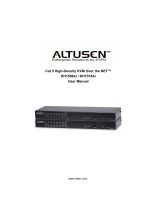
CC1000 Control Center over the NET Quick Start Guide
© Copyright 2006 ATEN
®
International Co., Ltd.
Altusen and the Altusen logo are trademarks of ATEN International Co., Ltd. All rights reserved. All other
trademarks are the property of their respective owners.
This product is ROHS compliant
2-1
The requirements for the computers running the Windows version of the CC1000 components are
given in the table below:
Component PC Requirements
CC1000 Manager • Windows Server Family
1
with IIS 5.0/6.0 and higher; Certicate
Services (CA)
2
, and SNMP congured
• At least one network card installed - two are recommended
• A USB host controller and USB Type A (F) port installed so that
it can accept the CC1000 USB authentication key
CC1000 Log Server Windows 2000 / XP / or Windows Server Family
1
with Microsoft
Jet Database
Note:
This component can either be installed on a PC running
one of the other components, or on an independent PC.
CC1000 Authenticaton Server Windows Server Family
1
with Active Directory (AD); and
Certicate Services (CA) congured
Note:
This component can either be installed on the PC that the
CC1000 Manager is on, or on an independent PC.
CC1000 Administrator Utility Windows 2000 / XP / or Windows Server Family
1.
Note:
This component can either be installed on a PC running one
of the other components, or on an independent PC.
System Requirements
3
For security purposes, the USB Authentication Key can be installed inside the case. To do so, refer
to the diagram below as you perform the following steps:
External Cable Installation
1. Install the USB key bracket that came with your CC1000 package into one of the computer's
expansion slot openings.
2. Plug the USB Authentication Key into the USB socket on the bracket.
3. Plug the bracket cable into one of the computer's USB ports.
USB Authentication Key Bracket Installation
Internal Cable Installation
1. Perform steps 1 and 2 as above period
2. Plug one end of the USB internal connector cable onto the bracket.
Note:
The red wire goes to pin 1 (at the bottom of the bracket)
3. Plug the other end of the cable into a USB connector on the mainboard – (see your mainboard
manual for the connector’s location)
4-1
1.Install and set up Windows Server; making sure to install AD (Active Directory), CA (Certicate
Authority), and IIS (Internet Information Services).
2. Install and set up the CC1000 server software - making sure that IIS and SNMP have been
properly congured, and that the USB key has been plugged into the computer running the
CC1000 Server software.
3. Launch the CC1000 Log Server. Conguration of the Log Server must be performed the rst time
that the program is launched.
Note:
If the Log Server is installed on the same machine as the CC1000 Manager, you don't
have to launch the Log Server. It will launch automatically when you launch the CC1000
Manager.
4. Launch the CC1000 Manager. Conguration of the CC1000 Manager must be performed the rst
time that the program is launched.
5. Launch the CC1000 Administrator Utility to add and congure devices and users. These
procedures must be performed the rst time the program is launched, and whenever device or
user information changes.
6. Make sure that ANMS (Authentication Network Management Service) support has been properly
set up in your ALTUSEN/ATEN IP devices.
(see ow chart in next panel)
Windows Version Installation
4-2
Note:
1. Installation of Windows updates is optional, but strongly recommended.
2. It may be necessary to reboot between the procedures.
Windows Version Installation – Flow Chart
Installation Overview
1
Package Contents
• 1 CC1000 USB Authentication Key
• 1 USB Extension Bracket
• 2 USB Cables (1 External; 1 Internal)
• 1 Software CD
• 1 User Manual
• 1 Quick Start Guide
• 1 Registration Card
Note:
There are two versions of the CC1000: A Windows Version, and a Java Version
(includes Java for Windows and Java for Linux). You cannot install both versions.
You must choose between the Windows version and the Java version.
2-2
System Requirements
Note:
1. For the Windows Server Family you can use any of the following Windows operating systems:
Windows 2000 Server, Windows 2000 Advanced Server, Windows Server 2003 Standard
Edition, Windows Server 2003 Small Business Edition, or Windows Server 2003 Enterprise
Edition.
2. All PCs must be have all of the latest updates from the Microsoft Update Website installed.
3. All ALTUSEN "Over the NET™" and ATEN "On the NET™" products must be at a rmware
level that contains the CC Management function, and the CC Management function must be
enabled. Download and install the latest version of the relevant rmware from our website, if
necessary.
The software requirements for the computers running the Java version of the CC1000 components
are as follows:
• OS: Windows 2000 / XP / Server Family, or Linux
• Java: SDK 1.4.2 or higher
• OpenLDAP: 2.2.29 or higher (Windows) or 2.1.22 or higher (Linux)
(Continues on 2-2)
(Continues from 2-1)






